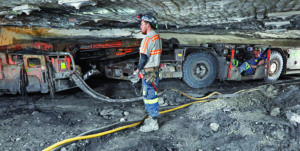
After winning the Mine Safety & Health Technology Innovation Award from the National Institute for Occupational Safety and Health in 2021, Enhanced IntelliZone is introduced at MINExpo, specifically as a proximity detection solution for underground haulage equipment. (Photo: Matrix Team)
The top systems now give a bigger safety zone, offer more options and features, and can do more applications than previous systems
by jesse morton, technical writer
Advances in automation underground over the years have, in general, moved workers away from both the longwall and the continuous miner. Such has undoubtedly increased safety. It has also created new challenges for further ensuring the safety of the few that still operate those machines. The suppliers of the more popular proximity detection systems in the U.S. have risen to the occasion. The development and perfection of those systems in recent years created opportunities to add features and capabilities, which are now being more widely adopted.
Enhanced System for Mobile Machines
Matrix Team reported it continues to deploy IntelliZone on scoops and, more recently, shuttle cars. “We’ve mounted the Status Screen, a key component of the enhanced system, to continuous miners as well to assist in troubleshooting and minimize downtime,” said Brian Jones, vice president, business development.
“The performance enhancements we’ve made to our original IntelliZone product have resulted in additional implementations both domestically and internationally,” he said. “With the soaring price of coal, any additional tool we can provide that enables a reduction in downtime is a necessity.”
Proximity detection solutions are seeing an uptick in demand “because the coal market is in a historical boom at the moment, which in turn enables operators to add production units and open new operations,” said Chris Adkins, mining manager.
“These expansions obviously increase productivity across the board,” he said. “With additional production, though, inherently comes additional risk.”
The trend has prompted “adding proximity detection to powered haulage,” Adkins said. Proximity detection for haulage equipment helps promote safety protocols to a relatively new workforce.
“With the market becoming so active right now, coal operations are hiring new employees that may have less experience around mobile equipment and continuous miners,” said Bruce Hunt, field service manager, eastern U.S. “Proximity detection has a key role to play in teaching newer employees to reside in safe areas and to stay out of harm’s way.”
IntelliZone’s patented SharpZone technology creates shaped zones that expand or contract depending on the speed and direction of the equipment. “Ultra-precise,” it provides “enhanced safety and maximum productivity with minimal nuisance stops,” Hunt said.
SharpZone can be programmed with customized Caution, Operator and Shutdown zones. When the Caution Zone is breached, audible and visual alerts are triggered. In the Operator Zone, for continuous miners, the operator can work in a set area of the Caution Zone without triggering alerts. When the Shutdown Zone is breached, equipment movement is halted and alerts are triggered.
IntelliZone has been on the market for more than a dozen years, and within months of release saw relatively rapid uptake in underground coal in the U.S.
When the U.S. mandated proximity detection solutions on continuous miners in 2015, demand for the solution increased. As demand for it grew both in the states and abroad, IntelliZone began to be more regularly deployed to mobile machines, including shuttle cars, roof bolters, loaders, battery-powered scoops and battery haulers.
It was introduced to the South African market in 2016, and since then has been installed on hundreds of machines.
In 2020, Matrix Team released the Status Screen, which helps operators and maintenance personnel monitor system health and view the status of system users and components. It also introduced the Machine-Mounted Locator, which allowed the system to run more self-health checks and to optimize zones.
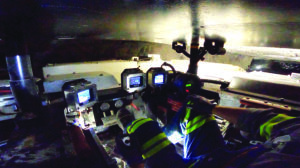
Enhanced IntelliZone is increasingly being installed on scoops and shuttle cars. The system helps promote safety protocols to a relatively new workforce. (Photo: Matrix Team)
In the months that followed, three large coal companies with mines across the U.S. installed standard IntelliZone on about 100 pieces of equipment, including scoops and powered haulage. The feedback showed the system was a viable proximity detection solution for mobile equipment underground, and workers favored it.
In 2021, Enhanced IntelliZone won the Mine Safety and Health Technology Innovation Award from the National Institute for Occupational Safety and Health. Later in the year, the solution was introduced at MINExpo specifically as a proximity detection solution for underground haulage equipment.
Enhanced IntelliZone comes with additional hardware, including dual-function UVision lights: white headlights and red tail lights. UVision combines the brightness of LEDs with safe-spectrum ultraviolet to deliver a 50% brighter light that increases the visibility of miners wearing reflective clothing.
With improved controls and alarms, and long-range through-curtain detection capabilities, the solution offers both efficiency and proficiency. “Even when coal prices are climbing, production efficiency is essential,” Jones said.
“Operators understand the increased risks and continue to implement proximity detection on new machinery in their operations,” he said. “This not only speaks to the safety dedication of the mine operators but to their trust in the systems to provide minimal impact to production.”
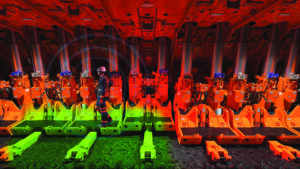
Komatsu expands the range of the Personal Proximity Detection (PPD) system for longwalls to cover the gate-end. It inhibits the BSL push if an operator is in a hazardous roadway, and it protects against conveyor pullback in the gate ends. (Image: Komatsu)
Expanded Protection at the Longwall
Komatsu reported it expanded the range of the Personal Proximity Detection (PPD) system for longwalls to cover the gate-end.
“We’ve worked with our customers to develop this advanced technology primarily engineered to protect operators on the longwall face,” said James Sudworth, global C&A manager, longwall systems.
“The system inhibits the BSL push if an operator is detected in a hazardous roadway,” he said. “The system also protects against conveyor pullback in the gate ends.”
Simple in concept, but complex in functionality, PPD “consists of tags, a tag charger and a surface station,” Sudworth said. Each tag has a built-in tiny radio transceiver.
“This technology features MiWi, a proprietary wireless protocol that uses small, low-power digital radios based on the IEEE 802.15.4 standard,” Sudworth said.
The tag is carried in a small leather pouch on the belt. It is powered by a rechargeable lithium-ion battery. The tag transmits the user’s location, identity and tag battery status.
On the surface, the user must register the tag before entering the work area. “The surface station manages the system, registers tags to users, tests functionality, and updates software,” Sudworth said.
When the user enters the longwall, a radio transceiver in the Joy RS20s Mimics measures the strength of the signal from the tag and runs an advanced algorithm to calculate the user’s position. Mimics on the longwall constantly monitors the tag and tracks the user, identifying exact location to within the space of one shield.
Tag movement across the longwall, status, and remaining battery life is “visible from the Mimic display and the Headgate computer,” Komatsu said.
A tag that fails to transmit properly or otherwise loses communication with Mimics triggers a lost tag alarm and pauses automation.
Data from the RS20s system is sent directly to the Joy Longwall Information System (LIS), “which allows control room personnel to track operators wearing tags on the face,” Sudworth said.
The software in the control room is identical to that on the longwall. On a computer screen, the LIS displays the operators in the work area and identifies those with live or lost tags. It gives user identification number, role, and remaining tag battery life.
PPD offers alarms and automatic shutdowns when a user enters specific areas. An approaching user will first enter a warning zone, which triggers alerts, before entering a halt zone, which basically pauses roof support automation. Even when roof support is remotely controlled, if “an operator is within the halt zone of the roof support, then control is paused,” Sudworth said.
The zones are parametrized, “giving the mine the ability and flexibility to configure the proximity detection feature to best suit their operators and cutting sequences,” he said.
PPD is easy to install, he said. “The PPD transceiver is an integrated part of Mimic, so no extra hardware
is required.”
The comprehensive system was born of necessity, Sudworth said. “Unfortunately, the development of
our first longwall operator safety solution originated from a tragic incident in Australia where an advancing shield injured an operator.”
In response, Joy developed the operator position tracking feature. The feature mandates an operator to “press a button on Mimic to acknowledge status,” Sudworth said. “If the operator fails to press the button within a time period and operating range, the control system pauses roof support automation.”
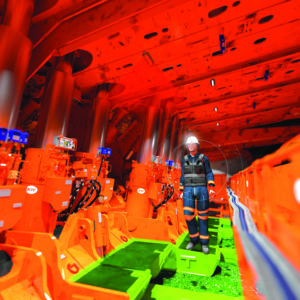
Komatsu’s PPD uses tiny low-power digital radios and advanced algorithms to monitor and track an operator to within the space of a shield. It can be configured to trigger alarms and automatic shutdowns when needed. (Image: Komatsu)
Subsequently, Komatsu engineers developed the shearer remote motion monitoring feature. “The Joy shearer radio remote was fitted with sensors to detect free fall, impact and no movement,” Sudworth said. “Under these conditions, the shearer haulage is disabled, all motors de-energized, and roof support automation is paused.”
Other incidents in Queensland “with operators working around the BSL and rib area when gate end automation was in operation” added to the need and inspired further development, he said.
PPD was then developed with “feedback from customers” on ways to further “improve operator safety,” Sudworth said.
PPD answers some of the unique challenges posed by increasing automation in the longwall mining process. “As automation takes a larger role, operators are being moved farther away from the face and farther away from the associated risks,” Sudworth said.
“However, fewer operators also mean less visibility to other mine personnel,” he said. “This lack of visibility is a concern if alone operator becomes incapacitated through illness or injury and is placed at further risk from automated longwall equipment.”
The risk was significant, customers reported. “So we created a technology designed to reduce injuries to longwall equipment operators through a personal proximity detection system,” Sudworth said.
Compared to earlier solutions, PPD offers increased tracking range and coverage, he said. It “eliminates dead spots,” he said, “and includes roadway tracking.” Most importantly, it “reassures the mine that if an operator is detected within the halt zone, the shield will be paused and set to the roof or the push paused.”
Originally developed for the Australian market, PPD has also been successfully deployed in North America and China.
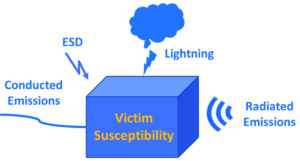
Protecting victims: Electromagnetic smog can cause, and historically has caused, interference in the operations of proximity detection system components, and may need to be regulated, the Pittsburgh office of NIOSH reports. (Image: NIOSH)
Government Mulls EMI Standards
by jesse morton, technical writer
Citing instances of electromagnetic interference (EMI) of proximity detection system (PDS) components by personal dust monitors (PDM), a report1 by the Pittsburgh Mining Research Division of the National Institute for Occupational Safety and Health (NIOSH) called for government standards for EMI in underground coal.
EMI occurs when electromagnetic radiation emissions from a machine or technology interferes with the operation of another. The former is called the source, the latter is called the victim, and the action of interference is called coupling.
The phenomena is common and growing as mines increasingly adopt advanced wireless technologies, electric machines, and the supporting infrastructure for both, according to NIOSH.
The “most recent notable instance” includes magnetic field radiation from a PDM interfering “with the normal operation of a PDS,” the report said.
“It has been discovered that PDMs can produce harmful EMI that cause PDS to stop working without any notice,” NIOSH reported. “The EMI can disable the protections from a PDS designed to stop the machine before a miner is contacted.”
Further, the PDMs that cause interference “have been certified that they operate in compliance with EN61326-1: 2005 and FCC Part 15 subpart B in reference to electrical emissions and immunity.” Immunity is the ability to resist EMI.
Another noted occurrence was an ultra-high frequency radio with a 5-watt transmission output interfering with the operation of a PDS.
“Under this interference, the locator will appear to be functioning but may not be detected by a PDS,” the report said. “In addition, the functionality of a locator will not resume until it is reset by placing it on the charger.”
Other noted instances include EMI from portable radios disrupting the functionality of remote-control transmitters, atmospheric monitoring systems and sensors, cap lamps and methane sensors.
Electromagnetic radiation emissions are seen as possibly capable of triggering accidental detonations. In many states, mobile phone use is prohibited within a set proximity to blast sites.
The Sago mine disaster of 2006 has been linked to a lightning strike, and could be an instance where a form of EMI played a role in an accidental detonation, NIOSH reported.
Electromagnetic fields underground in general have been studied by the government for decades. EMI, as a hazard, has not been exhaustively studied, the report said.
Government- or industry-set EMI standards have been adopted for military equipment, some consumer goods, some surface mining equipment, and for the automotive industry. Some of those standards could apply to technologies and solutions that ultimately do get deployed underground, NIOSH reported. Otherwise, EMI underground is currently largely unregulated.
Measures miners can take to reduce EMI include shielding, filtering, grounding and distancing.
Shielding involves “placing a conductive or magnetic surface around a device or component” to reduce transmission. Filters “suppress any unwanted current conducted through wiring or cables while allowing desirable currents to flow freely,” the report said.
“Proper electromagnetic current grounding strategies can ensure that large metal structures in a system or circuit cannot be driven relative to each other,” NIOSH said. “Proper grounding is important to the effectiveness of other EMI mitigation strategies.” For example, shielding works only if the shield is “properly grounded.”
Distancing basically requires managerial action and steps. Electromagnetic field strength “decreases dramatically with increasing distances, so maintaining a minimum separation distance between the source and the victim can be another effective way to reduce the EMI effects.”
NIOSH advises miners to follow the recommendations and best practices suggested by manufacturers. OEMS should design products with immunity to EMI, it said. OEMs should provide information on the electromagnetic radiation emissions of their products, and mine managers and engineers should take that information into consideration when planning.
Government-set standards are encouraged, NIOSH said. “Similar to EMI standards that were developed in many other industries decades ago, ultimately, mining-specific EMI standards may need to be promoted to overcome the increasing EMI issues in underground mining.”




